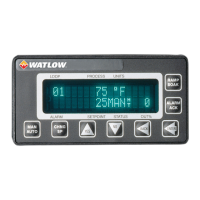CLS200 Series User’s Guide
Chapter 5: Enhanced Features
102
DISPLAY USER INPUT
ALARM
02 HEAT RETRANS
MIN INP? 0
Enter the minimum input value, which corresponds to the
minimum output percentage. For a range of 0 to 1000˚ F, set
the minimum input value to 0˚ F. Press ENTER.
ALARM
02 HEAT RETRANS
MIN OUT%? 0
Enter the minimum output percentage, from 0 to 100%. For
this example we will assume a full span with a minimum of
0%. Press ENTER.
ALARM
02 HEAT RETRANS
MAX INP? 1000
Enter the maximum input value, which corresponds to the
maxi-mum output percentage. For a range of 0 to 1000˚ F, set
the maxi-mum input value to 1000˚ F. Press ENTER.
ALARM
02 HEAT RETRANS
MAX OUT%? 100
Enter the maximum output percentage, from 0 to 100%. For
this example we will assume a full span with a maximum of
100%. Press ENTER.
ALARM
02 COOL OUTPUT
RETRANS PV? NONE
The process variable retransmit section of the controller
program-ming is now completed. We are not using the cool
output of loop 2 to retransmit a process variable, so choose
NONE. Press ENTER.
Notes about this application:
• This is not a thermocouple curve type of signal and requires a linear input range in the
recorder.
• To complete this configuration, the loop 2 output must be enabled and tailored to meet the
requirements of the data application. In this example, the data logger requires an analog input
of 4 to 20mA.
• The CLS200 Series controllers must be used with a Watlow Serial DAC.
Consult Chapter 4: Setup for information on setting up the other options of the controller.
Cascade Control
Cascade control is used to control thermal systems with long lag times, which cannot be as
accurately controlled with a single control loop. The output of the first (primary) loop is used to adjust
the setpoint of the second (secondary) loop. The secondary loop normally executes the actual
control.
The cascade control feature allows the output percentage of one control loop to determine the
setpoint of a second control loop. By adjusting the setpoint (SP) parameters, the user can adjust the
influence that the primary loop has on the setpoint of the secondary loop. See Figure 5.4.

